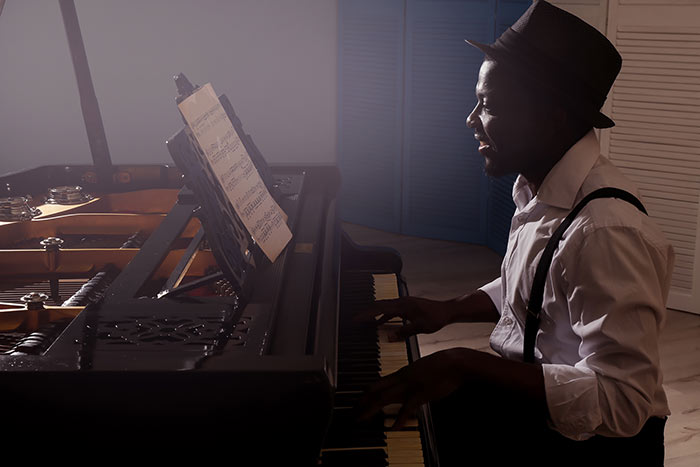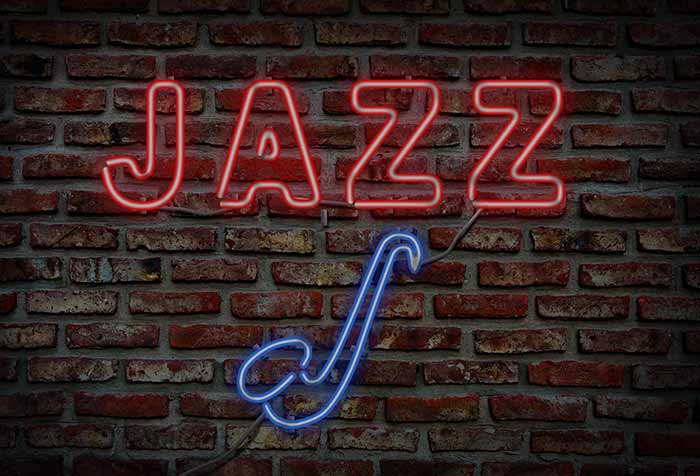The basic chords used in jazz for the adult beginner
In this article, I will try to capture some of the basics of jazz to help you as an adult beginner. The most important ingredient in playing jazz being the chords you use. It’s like the bricks in a wall. Knowing your basic chords and scales needs to be a foundation to work from. We will look at how chords are structured or built and their extensions. Starting as an adult beginner, learning to play jazz could take quite some time just to master the basics.
Moving from classical musician to jazz musician
I remember, when studying jazz as a classically trained musician, the jump from classics to jazz was quite huge. For the first year, I literally sat for hours in front of the piano, just figuring out and practising basic voicings of chords. But, thankfully after some time of redoing and redoing, it pays off and becomes natural to be able to play them without thinking. There is, of course, a multitude of ways to voice every chord which gives you the ability to create and enjoy the sounds which speak to you! We will discuss voicings in a next article.
Knowing all the keys, scales and chords
As a full-time jazz student, students normally are given all the keys, all the scales and all the chords and expected to conquer these in a very short period of time. This is quite a daunting task! When you study classical piano and do external exams, you are expected to learn all the basic scales over a period of more or less 8 years, starting from grade 1 to 8. This makes you realise the extent of the work involved here, learning all your scales, keys and chords.
Knowing your scales
Knowing your scales will help you greatly with chord structuring. We will later discuss the use of jazz scales and modes. For a start, the adult beginner needs to start to work towards getting to know the basic major and minor scales. We talk about the circle of 5ths which makes it easier to learn the different major scales with its sharps and flats.
The circle of 5ths
What are the circle of 5ths? Its a circle drawn in order to remember scale names and their flats or sharps. With the circle – we always count up 5 notes and the 5th note then becomes the next key.
How is the circle of 5ths structured?
It starts from the C note on the piano. Our first key is the C major key with no sharps or flats. The black notes on the keyboard are referred to as sharps and flats. (A note is sharpened when the sound is raised a half a tone or the closest note to the right side of the note sharpened. With the flats, its the note closest to the left side. The sound is flattened or lowers with a semitone or half a tone.)
Count up 5 notes and land on the G. The new key will be G major with 1 sharp, which is F# (sharp) (It is the black note the closest to the left of the G note).
Then count up 5 notes from the G note and land on the D note, so that the next key will be D major with 2 sharps. The new sharp is C# (again the closest black note to the D note) and take note that the former F# is retained. It means that the scale of D major has two sharps being F# and C#. This way the circle builds up till we reach the C# major key.
The circle of 5ths also works backwards, counting 5 notes downwards (lower) for the flat keys. Again starting on C counting 5 notes down, which lands us on F bringing us to the F key which has one flat – the Bb. You will be able to find this circle of 5ths on the internet or in any book on rudiments of music.
Here are the basic keys and their sharps or flats.
Sharp Keys:
Key of C major No sharps
Key of G major 1 sharp F#
Key of D major 2 sharps F# C#
Key of A major 3 sharps F# C# G#
Key of E major 4 sharps F# C# G# D#
Key of B major 5 sharps F# C# G# D# A#
Key of F# major 6 sharps F# C# G# D# A# E#
Key of C# major 7 sharps F# C# G# D# A# B#
Flat keys:
Key of C Major No flats
Key of F Major 1 flat Bb
Key of Bb Major 2 flats Bb Eb
Key of Eb Major 3 flats Bb Eb Ab
Key of Ab Major 4 flats Bb Eb Ab Db
Key of Db Major 5 flats Bb Eb Ab Db Gb
Key of Gb Major 6 flats Bb Eb Ab Db Gb Cb
Key of Cb Major 7 flats Bb Eb Ab Db Gb Cb Fb
Using the circle of 5ths will help you work through the keys and their key signatures. For the adult beginner, this will be too much to take in but will help you understand the building up of the different keys.
Start learning a few easier keys, like C, G, D and F. As you are learning jazz standards one at a time, you will automatically have to learn the keys and scales within the jazz standard. Rome wasn’t built in a day so do not be put off by all this information. Fortunately, one does not have to know every single scale or chord before you can play, but it is a great tool to have.
Let’s look at the foundational chords used in Jazz and how to structure them
Jazz is built on 7th chords with extensions or tensions added. Not on triads as in classical music. As a start, we need to look at the simpler chords (triads) used in classical music and then move on to the jazz chords from there.
Chords in Classical music:
Chords sounds used in classical and pop music are basically the following chord sounds:
major/ minor/ augmented / diminished
These chords are usually triads, ie, chords built by playing 3 notes together. Therefore called a triad. It consists of 3 notes played together.
The chords are built from the root note (the bass note) called the 1st degree or root note, then one note is skipped and the 3rd note is played, the next note is once again skipped and the 5th note is played. The numbers used are from the root or bottom note of the chord counted as number 1. It means we will have 1 (root), 3 (third) and 5 (fifth) played together. If you are structuring the C major chord, you will be working it out from the C major scale. It’s basically a stack of 3rds on top of each other forming the basic triad. When you talk of the stack of thirds, I am talking of the interval of a 3rd. Playing 2 notes together which is a 3rd apart or 3 notes apart. All the chords are built up with 3rds stacked on top of one another.
What is meant by 1 3 5 7?
If we talk of the 1 3 5 – it relates to the degrees of the scale from where the chord is built. The scale has 8 notes being numbered from nr 1 to 8. This means that note no 1 in the C chord will be derived from the C major scale and will be the C note being the 1st note of the scale. The 2nd note will be D and so it moves up. The 8th note is the same as the starting note, but an octave or 8 notes higher. Our chords are built on these degrees or steps or notes that are numbered from 1 to 8. The bass note of the chord is the 1st degree of the scale we work from.
The root or bass gives us the bass note or root or the foundation of the chord.
The 3rd of the chord gives us the major or minor sound and defines the chord.
The 5th degree is less defining but often used with the bassline.
The 7th is used in classical music for the dominant 7th chord.
The basic triads or chords used in classical music:
The C Major Chord:
The degrees 1 3 5 on the C major scale will form the C major chord.
The notes will be C E G (1-3-5)
For the C Minor chord:
Degrees: 1 b3 5 (3rd is flattened in the C major scale)
Notes: C Eb G
For C Augmented chord:
Degrees: 1 3 #5 (5th is sharpened in the C major scale)
Notes: C E G#
For C Diminished chord:
Degrees: 1 b3 b5 (3rd and 5th flattened in the C major scale)
Notes: C Eb Gb
The 7th is sometimes added in classical music and mostly when the dominant 7th is played. It means that another 3rd interval or “chord” is added no top of the 5th degree. It means the 6 note of the scale is skipped and the 7th is added. In the dominant 7th chord, the 7th is a flattened 7th (b7).
For C dominant 7th:
Degrees: 1 3 5 b7 (7th is flattened in the C major scale)
Notes: C E G Bb
The diminished 7th and augmented 7th are also sometimes used.
Chords in Jazz Music:
In Jazz music, the basic chord “sound” is built on 7ths chords and not on the simpler triads or the Classical style.
There are three basic 7th chords: These chords consist of 4 notes played together to form the chord and not 3 notes as in the triads. These are the basic 7th chords used in jazz:
● The Major 7th chords,
● The Minor 7th chords
● The Dominant 7th chords
To build a 7th chord, you have to add the 7th step to the triad. So you will be playing notes: C E G B to from the major 7th chord built on the C. It means you will be using the following degrees of the C major scale: 1, 3, 5 and 7. When playing these together, it will be called a 7th chord, as the 7th step is added.
There are different 7th chords available as already mentioned. Major 7ths and minor 7ths and dominant 7ths are the most common, depending on the sound of the 7th note added and the makeup of the chord.
The root gives us the bass note or root of the chord and can not usually be omitted (unless you are playing rootless chords as when playing with a band.)
The 3rd of the chord gives us the major or minor sound and defines the chord.
The 5th is the 5th degree of the scale. The 5th can be omitted in chords.
The 7th is the tension we need to create the jazz sound with and is of absolute importance.
The only tone that could be omitted without changing the sound of your chord is the 5th of the chord. If we talk of the root, 3rd or 5th or 7th etc. – it relates to the degrees or numbered steps of the scale from where the chord is built. So the bass note of the chord is the 1st degree/note of the scale we work from.
The three basic 7th chords used n Jazz:
The Major 7th chord:
This chord has a major triad (or chord) plus the natural 7th of the scale added. The scale is derived from the note on which the chord starts. The notes will be C E G B which is 1 3 5 7 on the C major scale degrees when you count up from the C note. Here are examples:
C Maj 7:
Notes: C E G B
Degrees: 1 3 5 7
So we are using the C major chord (triad) + 7th added to form the C major 7th chord.
The Minor 7th chord:
This chord has a minor triad plus the flattened 7th of the major scale from which it’s built.
C Min 7:
Notes: C Eb G Bb
Degrees: 1 b3 5 b7
The 3rd and 7th steps are flattened using the C major scale from which the chord is built.
So we are using the C minor chord (triad) + flattened 7th.
The Dominant 7th
This chord has the major triad plus the b7 (flattened 7th)
C 7:
Notes: C E G Bb
Degrees: 1 3 5 b7
So the dominant 7th chord consists of the C major chord (triad) + flattened 7th added.
Having the basics of knowing how the 7th chords are built, I suggest that you take time to familiarize yourself with the chords and practise them through a few keys. Make sure you have the right key signature and use your ears to listen and hear the difference between the major 7th, minor 7th and dominant 7th chords.
Train your ear to hear and to know the particular chord sounds. This “hearing” will help with building chords even if you are not totally familiar with the sharps of flats used. The ear in jazz is very important, as real jazz musicians rarely think of what they are playing. They have committed the sounds to their ears and fingers. This is the goal: to have a “dictionary” of chords or sounds and voicings that are available at any time to be played. It takes time to get there, but with a little bit of effort, it will come.
Practising the three basic jazz chords:
I trust that you will be able to grasp something of the jazz chords and its building thereof. On your lead sheet, you will have some chords with which you can start to experiment and practise.
Start practising the 3 basic jazz chords in some of the different keys with both hands. Playing them as arpeggios helps as well to help with the recognising of the chord tones use. I trust you will soon be able to enjoy and use the information on foundational chords.
In a next article, we will discuss extensions (like the 9th, 11th or 13th) that should and can be added to the 7th chords to create the sounds that are so typical in jazz.




![Man playing piano while the other man watches-] him feat](https://www.londonpianoinstitute.co.uk/wp-content/uploads/2024/02/man-playing-piano-while-the-other-man-watches-him_feat.jpg)


